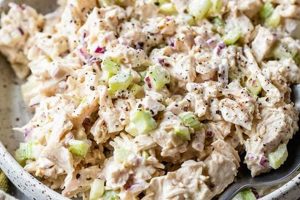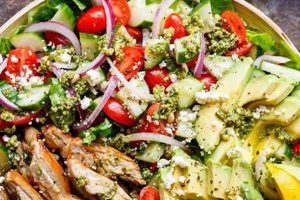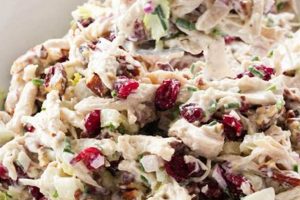This dish typically combines cooked chicken, often shredded or diced, with a creamy dressing, noodles, and various other ingredients. Celery, onion, grapes, and nuts are common additions, creating a flavorful and texturally diverse cold pasta salad. Variations can include different types of noodles, dressings, and supplemental ingredients like dried cranberries or apples, catering to a wide range of palates.
A versatile meal option, this cold pasta salad is suitable for picnics, potlucks, quick lunches, or light dinners. Its adaptability allows for customization based on dietary preferences and seasonal ingredient availability. Historically, similar dishes have existed for centuries, evolving alongside refrigeration and mayonnaise production, eventually leading to the contemporary versions enjoyed today. The affordability and ease of preparation further contribute to its popularity as a convenient and satisfying meal.
Further exploration of this culinary creation can involve examining specific recipe variations, exploring the nutritional value of different ingredient combinations, and discussing techniques for optimal preparation and storage.
Tips for a Superior Cold Chicken and Noodle Salad
Optimizing ingredient selection and preparation techniques elevates this simple dish to a culinary delight. Attention to detail ensures a flavorful, texturally appealing, and satisfying meal.
Tip 1: Chicken Selection and Preparation: Utilizing rotisserie chicken offers convenience and flavor depth. Alternatively, poaching or grilling boneless, skinless breasts allows for controlled seasoning and texture. Careful shredding or dicing ensures consistent bite-sized pieces.
Tip 2: Noodle Choice: Classic egg noodles provide a neutral base that absorbs flavors well. Rotini, farfalle, or other short pasta shapes offer interesting textural variations. Cooking noodles al dente prevents a mushy final product.
Tip 3: Dressing Enhancement: While mayonnaise is traditional, incorporating Greek yogurt or sour cream adds tang and reduces overall fat content. Freshly squeezed lemon juice brightens the flavor profile. Experimenting with Dijon mustard, herbs, and spices adds complexity.
Tip 4: Ingredient Incorporation: Adding ingredients like celery and onion provides crucial textural contrast and flavor dimension. Finely dicing these elements ensures even distribution throughout the salad.
Tip 5: Balancing Sweet and Savory Elements: Incorporating sweet elements like grapes or dried cranberries complements the savory chicken and dressing. A touch of sweetness enhances the overall flavor profile.
Tip 6: Chilling and Serving: Chilling the salad for at least an hour allows the flavors to meld and the noodles to absorb the dressing. Serving chilled maximizes enjoyment.
Tip 7: Garnish and Presentation: A simple garnish of fresh herbs, chopped nuts, or a sprinkle of paprika elevates the visual appeal. Consider serving on a bed of lettuce for a more formal presentation.
By following these guidelines, one can achieve a well-balanced and flavorful cold pasta salad suitable for various occasions.
These preparation and ingredient suggestions provide a foundation for creating a memorable and satisfying dining experience. The adaptability of this dish encourages experimentation and customization.
1. Chicken (cooked, diced)
Cooked, diced chicken forms the foundational protein component of a chicken salad noodle recipe. Its preparation method and inclusion significantly impact the final dish’s overall quality, flavor, and texture. Choosing the right cooking method influences the chicken’s tenderness and moisture content, directly affecting the salad’s palatability. For instance, poached chicken offers a leaner, milder flavor, while roasted chicken imparts richer notes. Dicing the chicken into uniform pieces ensures even distribution throughout the salad and consistent bite size, enhancing the eating experience. Neglecting proper cooking and dicing can lead to dry, stringy chicken or unevenly distributed pieces, detracting from the salad’s overall appeal.
The choice of chickenwhether breast, thigh, or a combinationfurther influences the salad’s nutritional value and flavor profile. Using pre-cooked options, like rotisserie chicken, streamlines preparation while offering a distinct flavor profile. Alternatively, cooking chicken specifically for the salad allows for greater control over seasoning and ensures optimal freshness. Consider incorporating herbs and spices during the cooking process to infuse the chicken with deeper flavors that complement the other salad ingredients. The quantity of chicken also plays a crucial role; too little results in a less satisfying salad, while too much can overpower the other components.
Understanding the significance of properly cooked and diced chicken within the context of a chicken salad noodle recipe is crucial for creating a balanced and enjoyable dish. Attention to these details elevates a simple combination of ingredients into a well-executed, flavorful salad. Careful consideration of cooking method, dicing technique, and chicken type ultimately determines the success and satisfaction derived from the final product.
2. Noodles (cooked, cooled)
Noodles, a defining component of the chicken salad noodle recipe, contribute significantly to its texture, flavor absorption, and overall appeal. Proper noodle selection and preparation are essential for a successful dish. The type of noodle, cooking method, and cooling process all influence the final product’s quality.
- Noodle Variety:
Various noodle shapes and sizes offer diverse textural experiences. Classic egg noodles provide a neutral base, readily absorbing the flavors of the chicken salad dressing. Rotini, farfalle, and other short pasta shapes create visual interest and hold the dressing effectively. The chosen noodle type influences the salad’s aesthetic and how the ingredients interact.
- Cooking Technique:
Cooking noodles al dente is crucial. Overcooked noodles become mushy and detract from the salad’s texture. Undercooked noodles result in a firm, unpleasant bite. Precise cooking ensures the noodles offer a pleasant chewiness without becoming gummy. Salting the cooking water adequately seasons the noodles themselves, contributing to the overall flavor profile.
- Cooling Process:
Cooling the noodles thoroughly before incorporating them into the salad prevents the dressing from becoming watery and the chicken from overcooking. Rinsing the cooked noodles under cold water stops the cooking process and removes excess starch, improving the salad’s final consistency. Proper cooling maintains the salad’s integrity and prevents a sticky, unappetizing result.
- Noodle-to-Other-Ingredient Ratio:
The proportion of noodles to other ingredients influences the salad’s balance. Too many noodles create a bland, carbohydrate-heavy dish. Too few noodles result in a dense, overly rich salad. A balanced ratio ensures a harmonious blend of flavors and textures, where each component complements the others.
The interplay of these factorsnoodle variety, cooking technique, cooling process, and ingredient proportionsdetermines the success of the chicken salad noodle recipe. Careful attention to these details elevates the dish from a simple combination of ingredients to a well-balanced, texturally satisfying, and flavorful culinary experience. A proper understanding of the noodle’s role underscores its importance in achieving the desired final product.
3. Mayonnaise (or alternative)
Mayonnaise plays a crucial role in a chicken salad noodle recipe, binding the ingredients and contributing a creamy texture and tangy flavor. It acts as an emulsifier, creating a smooth, cohesive mixture and preventing the salad from becoming dry or crumbly. The quality and type of mayonnaise directly impact the overall flavor profile. Full-fat mayonnaise provides a richer flavor and creamier texture, while light mayonnaise offers a lower-fat option with a slightly tangier taste. The amount of mayonnaise used also influences the salad’s consistency, ranging from a lightly coated to a richly dressed salad. For example, a classic chicken salad often features a generous amount of mayonnaise, creating a creamy, decadent dish. In contrast, a lighter, healthier version might utilize a smaller quantity or incorporate Greek yogurt for a tangier, lower-calorie alternative.
Alternatives to traditional mayonnaise offer variations in flavor, texture, and dietary considerations. Greek yogurt provides a tangy, protein-rich alternative, while plain yogurt offers a lighter, milder option. Avocado can be blended into a creamy dressing, adding a healthy fat source and unique flavor. These alternatives cater to dietary restrictions and preferences, such as vegan or dairy-free diets, or simply provide a different flavor experience. For instance, a vegan chicken salad might use a cashew-based cream for a similar texture and richness. Using a vinaigrette-style dressing instead of mayonnaise results in a lighter, brighter salad with a different flavor profile. Each alternative influences the final product’s overall taste, consistency, and nutritional content.
The choice of mayonnaise or alternative profoundly impacts the final dish’s flavor, texture, and nutritional composition. Understanding the function of mayonnaiseas both a binder and flavor componentallows for informed ingredient selection and recipe customization based on individual preferences and dietary needs. Considering the interplay between mayonnaise and other ingredients ensures a well-balanced and enjoyable chicken salad noodle dish. The right choice enhances the overall dining experience.
4. Flavor Enhancements (Celery, Onion)
Flavor enhancements, such as celery and onion, play a critical role in a chicken salad noodle recipe, elevating it from simple to complex. These aromatic vegetables contribute not only distinct flavors but also textural nuances that create a more engaging culinary experience. Their presence provides depth and complexity, balancing the richness of the chicken and the creaminess of the dressing. Understanding their individual contributions and synergistic effects within the recipe is essential for achieving a well-balanced and flavorful final product.
- Celery’s Contribution
Celery offers a refreshing, slightly bitter counterpoint to the richness of the chicken and dressing. Its crisp texture adds a satisfying crunch. The subtle herbal notes of celery brighten the overall flavor profile, preventing the salad from becoming overly heavy. Finely diced celery distributes its flavor and texture evenly throughout the dish.
- Onion’s Role
Onion adds a pungent, savory depth. Its sharp flavor contrasts with the creamy dressing and mild chicken. Different onion varieties, such as red onion or scallions, offer varying levels of pungency and sweetness. The choice of onion influences the salad’s overall flavor profile. Finely diced onion minimizes harshness while maximizing flavor distribution.
- Synergistic Effects
The combination of celery and onion creates a synergistic effect, where the flavors and textures complement and enhance each other. The celery’s crispness and herbal notes balance the onion’s pungency, resulting in a more complex and nuanced flavor profile. This interplay elevates the overall salad experience beyond the individual contributions of each ingredient.
- Customization and Alternatives
While celery and onion represent classic flavor enhancers, other aromatic vegetables can be incorporated to create unique flavor profiles. Bell peppers, water chestnuts, or chopped scallions offer alternative textures and flavors. The choice of additional vegetables allows for customization based on personal preferences and desired flavor outcomes. Experimentation with different combinations broadens the culinary possibilities of this versatile dish.
The careful selection and incorporation of flavor enhancers, such as celery and onion, are essential for a well-rounded and flavorful chicken salad noodle recipe. Their contributions extend beyond mere flavor additions, influencing the overall texture and complexity of the dish. Understanding the individual characteristics and combined effects of these ingredients allows for informed choices and customized variations, ensuring a consistently satisfying culinary experience.
5. Sweet additions (grapes, cranberries)
Sweet additions, such as grapes and cranberries, contribute a crucial balancing element to chicken salad noodle recipes. Their presence introduces a contrasting flavor dimension that complements the savory components, preventing the dish from becoming one-dimensional. The interplay of sweet and savory elements enhances complexity and offers a more nuanced flavor profile. Exploring the specific contributions of various sweet additions reveals their impact on the overall composition and enjoyment of the dish.
- Grapes
Grapes offer a juicy burst of sweetness and a pleasing textural contrast to the other ingredients. Their refreshing sweetness balances the savory chicken and creamy dressing. Different grape varieties, such as red or green grapes, provide subtle flavor variations. Halved or quartered grapes ensure even distribution and prevent overwhelming individual bites.
- Cranberries (Dried or Fresh)
Cranberries introduce a tart-sweet element and a chewy texture. Dried cranberries offer a concentrated sweetness and a longer shelf life. Fresh cranberries provide a brighter, more tart flavor. The choice between dried and fresh cranberries depends on personal preference and desired intensity of sweetness and texture.
- Balancing Sweetness
The quantity of sweet additions influences the overall balance of the salad. Too much sweetness can overpower the savory elements, while too little can result in a bland dish. Careful consideration of the sweetness levels of other ingredients, such as the dressing, helps determine the appropriate amount of grapes or cranberries. Taste testing and adjustment are key to achieving the desired balance.
- Alternative Sweet Additions
While grapes and cranberries are common choices, other sweet additions can further customize the flavor profile. Chopped apples, diced pineapple, or mandarin orange segments offer alternative textures and sweetness levels. Exploring different fruits allows for personalized variations and expands the culinary possibilities of the dish. Consideration of seasonal availability and flavor compatibility with other ingredients ensures a successful outcome.
The strategic incorporation of sweet additions like grapes or cranberries elevates the chicken salad noodle recipe from simple to complex. This interplay of contrasting flavors creates a more dynamic and satisfying culinary experience. Understanding the specific contributions of each sweet element allows for informed choices and personalized adjustments, ensuring a balanced and delicious final product.
6. Seasoning (salt, pepper, herbs)
Seasoning, encompassing salt, pepper, and herbs, forms an integral part of a successful chicken salad noodle recipe. Appropriate seasoning elevates the dish beyond the simple sum of its parts, enhancing the inherent flavors of the chicken, vegetables, and dressing. Salt acts as a flavor enhancer, amplifying the existing tastes and creating a balanced flavor profile. Pepper adds a subtle heat and complexity, while herbs contribute aromatic depth and freshness. The careful balance and selection of these seasonings significantly impact the overall enjoyment and satisfaction derived from the final product. For example, a chicken salad featuring fresh dill and chives offers a brighter, more herbaceous flavor compared to one seasoned solely with salt and pepper. Similarly, the addition of paprika or garlic powder introduces distinct savory notes. The absence of proper seasoning results in a bland, uninspired dish, regardless of the quality of the other ingredients.
The type and quantity of seasoning should complement the other ingredients and desired flavor profile. Fresh herbs, such as parsley, dill, or chives, offer a vibrant flavor and visual appeal. Dried herbs provide a more concentrated flavor and longer shelf life. The choice between fresh and dried herbs depends on personal preference, ingredient availability, and desired intensity of flavor. Pre-mixed seasoning blends, such as poultry seasoning or herbes de Provence, offer convenient shortcuts but require careful consideration to avoid overpowering the other flavors. Adjusting seasoning throughout the preparation process, starting with the chicken and continuing through the dressing and final mixing, ensures a well-balanced and flavorful outcome. Over-seasoning can easily overwhelm the delicate flavors of the other components, while under-seasoning leads to a lackluster dish.
Mastery of seasoning within a chicken salad noodle recipe demonstrates culinary expertise and elevates the dish from ordinary to exceptional. Understanding the function of each seasoning elementsalt to enhance, pepper to add complexity, and herbs to contribute aroma and freshnessallows for precise control over the final flavor profile. Careful consideration of ingredient pairings and flavor balances ensures a harmonious blend of tastes and maximizes the enjoyment of the dish. Seasoning acts as the conductor of the flavor orchestra, bringing all the individual components together in a harmonious and satisfying symphony of taste.
Frequently Asked Questions
This section addresses common inquiries regarding the preparation and enjoyment of chicken salad noodle recipes. Clarity on these points ensures a successful and satisfying culinary experience.
Question 1: What type of noodles is best suited for this dish?
While egg noodles are a classic choice, various pasta shapes, such as rotini, farfalle, or shells, work well. The key is to select a shape that holds the dressing effectively and provides textural interest.
Question 2: Can rotisserie chicken be used?
Rotisserie chicken offers a convenient and flavorful shortcut. Ensure the chicken is properly shredded or diced before incorporating it into the salad.
Question 3: How can the richness of the mayonnaise be balanced?
Incorporating ingredients like celery, onion, and grapes provides textural and flavor contrasts to balance the richness of mayonnaise. A touch of acidity, such as lemon juice or vinegar, can also brighten the overall flavor profile.
Question 4: What are suitable alternatives to mayonnaise?
Greek yogurt, plain yogurt, or a blended avocado offer lighter and tangier alternatives to traditional mayonnaise. These options also cater to specific dietary requirements.
Question 5: How long can this salad be stored?
Properly stored in an airtight container in the refrigerator, the salad can typically last for 3-5 days. However, the quality and safety of the ingredients should always be assessed before consumption.
Question 6: Can this recipe be adapted for different dietary needs?
This recipe is highly adaptable. Gluten-free noodles can be substituted for traditional pasta. Vegan mayonnaise or yogurt alternatives cater to dairy-free diets. Adjusting the ingredients allows for customization based on individual dietary needs and preferences.
Addressing these common questions provides a foundation for successful preparation and enjoyment of the dish. A clear understanding of these aspects enhances the overall culinary experience.
Exploring specific recipe variations further enhances understanding and allows for personalized customization.
Chicken Salad Noodle Recipe
This exploration has examined the multifaceted nature of the chicken salad noodle recipe, from its core components to nuanced flavor enhancements. Ingredient selection, preparation techniques, and the interplay of flavors and textures contribute significantly to the final product. Understanding the role of each elementthe chicken, noodles, dressing, and complementary ingredientsallows for informed choices and recipe customization. The adaptability of this dish to various dietary needs and flavor preferences underscores its enduring popularity.
The continued evolution of culinary traditions ensures that this versatile dish will remain a staple, adaptable to changing tastes and ingredient availability. Exploration and experimentation with flavors and techniques offer a path toward continued culinary discovery and personalized enjoyment of this classic dish.






